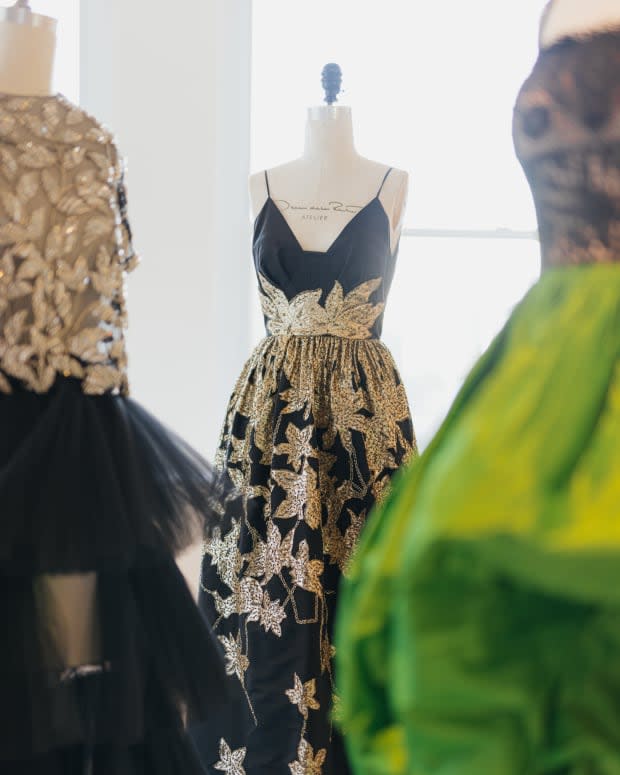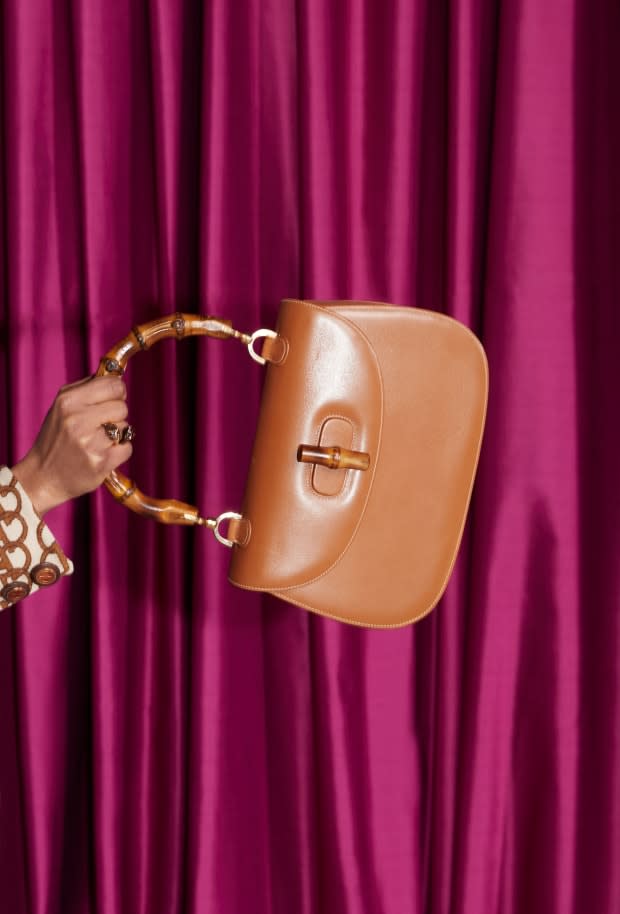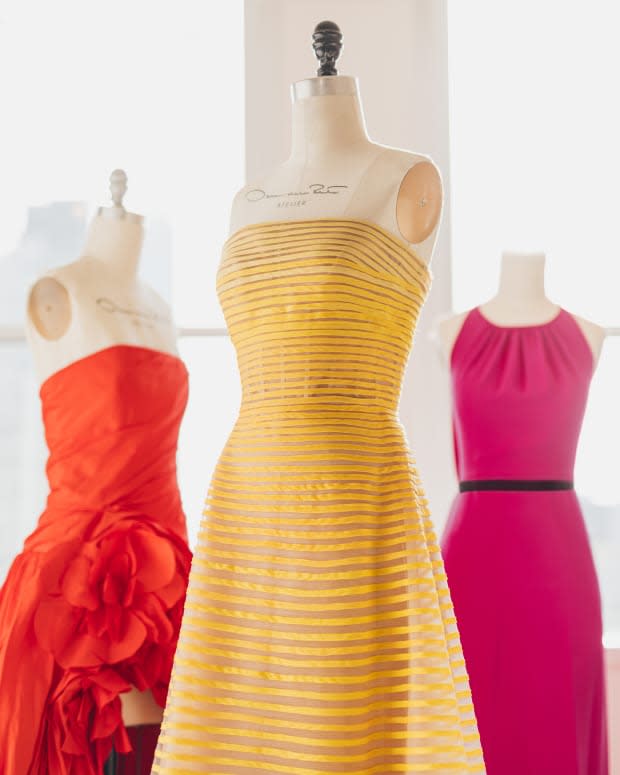Luxury Brands Are (Finally) Tapping Into Resale — What Does That Mean for the Secondhand Market?
- Oops!Something went wrong.Please try again later.
Over the last year, Oscar de la Renta, Valentino, Gucci and more announced they would start selling their own vintage. How will they compete with the third-party retailers that have dominated the resale business?
For Oscar de la Renta, the decision to tap into the secondhand space started with the customers themselves, sharing stories of discovering their mom's little black dresses from the '80s and the like.
"Our designs are very classic — quite timeless — so having heard these stories for many years and wondering how this might be a business opportunity, we started to explore what was going in the world of resale," says Alex Bolen, CEO of Oscar de la Renta, who explains that the brand keeps an in-house archive of designs from every collection. "We started to speak to vintage dealers around the country and looked at places like TheRealReal, Vestiaire Collective and other resale sites to source pieces for our archive, and we found that our customers were shopping there as well."
However, Bolen remembers how upsetting it was for the Oscar de la Renta team to see how poorly the brand was presented by third parties: Items were misidentified, there was a question of authenticity — all in all, it wasn't of the same caliber as the brick-and-mortar shopping experience that the brand prides itself on delivering. "We were very unhappy with it," he says.
That led to Encore, a resale platform launched last November that gives consumers the option to purchase vintage Oscar de la Renta runway designs, from Oscar de la Renta. It has allowed the luxury label to not only exercise full brand control online, but also to take back ownership of Oscar de la Renta items long after they were initially purchased. Plus, through a rigorous authentication and refurbishment process, the brand would be able to ensure a garment sees a second, third or fourth life.
"We think that seal of approval from the brand in terms of resale is hugely important," Bolen says. (To secure vintage items for Encore, Oscar de la Renta's sales teams reached out to top customers to see if they were interested in consigning previously purchased designs; to their surprise, per the executive, many refused until being offered the option of having the brand make a charitable donation.)

Photo: Courtesy of Oscar de la Renta
Encore was made possible by a partnership between Oscar de la Renta and Archive, a full-service resale company founded by Emily Gittins and Ryan Rowe at the end of 2020 that allows brands to either easily resell their own products or establish a marketplace in which customers can sell or buy pre-owned clothing. According to Gittins, Archive — which recently secured $8 million in funding — was born out of a desire to help brands that want to "take back ownership" of the secondhand market in light of the exponential growth third-party sites were seeing, but don't know exactly how.
"We really aim to support brands in a way that they still have ownership — they own the customer data, they own the program. We're just giving them the technology and the tools to facilitate that so they don't have to build everything from scratch themselves," she says. Clients include M.M.LaFleur, The North Face in Canada and Filippa K in Sweden, with about a hundred more interested brands currently in talks with the company.
"This industry is changing faster than I would expect. It's gone from brands saying, 'Secondhand is interesting; we feel like we should do something one day,' to brands coming to us with, 'Resale is one of our top three priorities for the year — we're just figuring out the exact strategy we want to take,'" she says. "It's really exciting.”
In the last year alone, a slew of other luxury brands have touched resale in one way or another — and in rapid succession. Last February, Alexander McQueen linked up with Vestiaire Collective to launch a buy-back program called "Brand Approved," allowing consumers to consign their pre-worn McQueen pieces for store credit. Several months later, Gucci introduced the Gucci Vault, a virtual concept store, now on its sixth drop, that houses a curated selection of designs from emerging designers with restored vintage Gucci pieces handpicked by Alessandro Michele.

Photo: Courtesy of Gucci
In October, Jean Paul Gaultier opened up its archives of 30,000-plus designs for consumers to either purchase or rent. That same month, Valentino announced four physical Valentino Vintage locations — in Milan, New York City, Los Angeles and Tokyo — in which consumers can bring in pre-worn Valentino clothing to be appraised for store credit; there are plans for the brick-and-mortar stores to sell a selection of Valentino Vintage in the near future.
Most recently, Burberry partnered with luxury rental and resale platform My Wardrobe HQ, to donate 30 items (several of which were sourced from consumers) to the platform and give 40% of each purchase to Smart Works, a U.K. charity that provides interview clothes and support for unemployed women in need. As of now, there are no plans for the brand to continue this partnership — this was, quite simply, a way to test the resale waters, gauge interest and ultimately figure out what resale might look like for it in the future, as well as a continuation of the heritage British brand's sustainability efforts.
Sustainability — and consumer demand for companies to make it a priority, more crucially — is an obvious driver of luxury brands' sudden and immense interest in resale. One way to achieve circularity is by extending the lifespan of garments and keeping them in use for longer. A luxury product, which tends to be higher in quality and constructed with the intention to be repaired and worn over and over again, naturally lends itself to resale. And there's value in it, too, whether it's sentimental (like, say, stories inextricably woven into a Burberry trench coat that was passed down from generation to generation) or qualitative (a rare and sought-after '60s Oscar de la Renta design, for example). That's one thing Bolen hopes to reinforce with Encore: the changing of consumer's perception of luxury fashion from a disposable product to an investment good.
"If customers suddenly learn that the old Oscar de la Renta dress they have in their closet is worth something, it can change the way people approach the new seasonal fashion they're buying," he says. The reception of the Encore's two drops so far has "exceeded beyond our wildest dreams": Eight pieces out of 30 in the first one sold out on the first day. "And [resale] is a way to talk to customers who, for whatever reason, might not be ready to shop our current merchandise. It's another way for her to experience Oscar de la Renta. We look at this as a way for us to attract both new customers and also, very importantly, retain existing customers."
Accessibility (71% of buyers purchase secondhand from brands that they otherwise wouldn't be able to afford) and brand loyalty (cash and store credit are used as incentives for existing customers to sell pre-owned items) are two big reasons why entering the resale space is good for business, Gittins says. Oscar de la Renta confirms the latter: When given the choice, 75% of Encore sellers opt for store credit, further illustrating how resale can lead to customer retention.

Photo: Courtesy of Oscar de la Renta
Another reason behind the timing of this seismic shift toward resale — now, in the last 12 months, as opposed to five years ago — is the pandemic.
"Covid was an accelerator of trends that were already happening: You had more focus on e-commerce from brands and more desire to use e-commerce from customers. Offering resale digitally is a much more scalable option than trying to embed it into physical stores," Gittins says. "And on the consumer side, there were buyers with less disposable income and more sellers who were spending more time at home — it feels like a natural thing to go into your closet and pull out the things you loved in the past and put them back into the world." (There were 36.2 million first-time sellers and 33 million first-time thrifters in 2020, according to ThredUp's 2021 Resale Report.)
But we're just at the beginning. Gittins predicts that luxury brands adopting resale will not only normalize buying secondhand, but also expedite the growth of it even further.
"Our hope is that it becomes the industry standard for every brand to have its own resale channel, and from a consumer perspective, it becomes a normal part of shopping in much the same way as e-commerce,” she says. “I think it will shift business models, because there’s now this opportunity to generate revenue from the second, third, fourth purchase of a garment, which means that brands can invest in high-quality products that stand the test of time — that’s worth it for them because they see those dividends down the line.”
That's not to say she believes third-party resale sites will cease to exist. Rather, brand-specific resale platforms (which offer authenticity, original photography, a more elevated shopping experience and so on) and multi-brand players (a diverse selection for consumers who aren't necessarily loyal to one specific label) will evolve and thrive together.
For Oscar de la Renta, the future of Encore is still up in the air. Right now, only runway creations are considered, but opening that service up to pieces from commercial collections (so someone could sell a navy blue skirt, for example, versus just a feathered cocktail dress) is something Bolen hopes to achieve. Or auctioning off a celebrity-worn dress for charity. Or building a 1stDibs-type marketplace featuring non-Oscar de la Renta jewelry or antiques. The options are endless.
"It's a big experiment, and we're excited about it," Bolen says. "If this was only a way to attract new customers and give us the opportunity to have a dialogue with existing customers, that would be enough for us — because when we're in conversation with our customers, we know what she needs. If she's talking to us, she's not talking to our competition. And resale is very much a way for us to be more involved in her life."
Never miss the latest fashion industry news. Sign up for the Fashionista daily newsletter.
